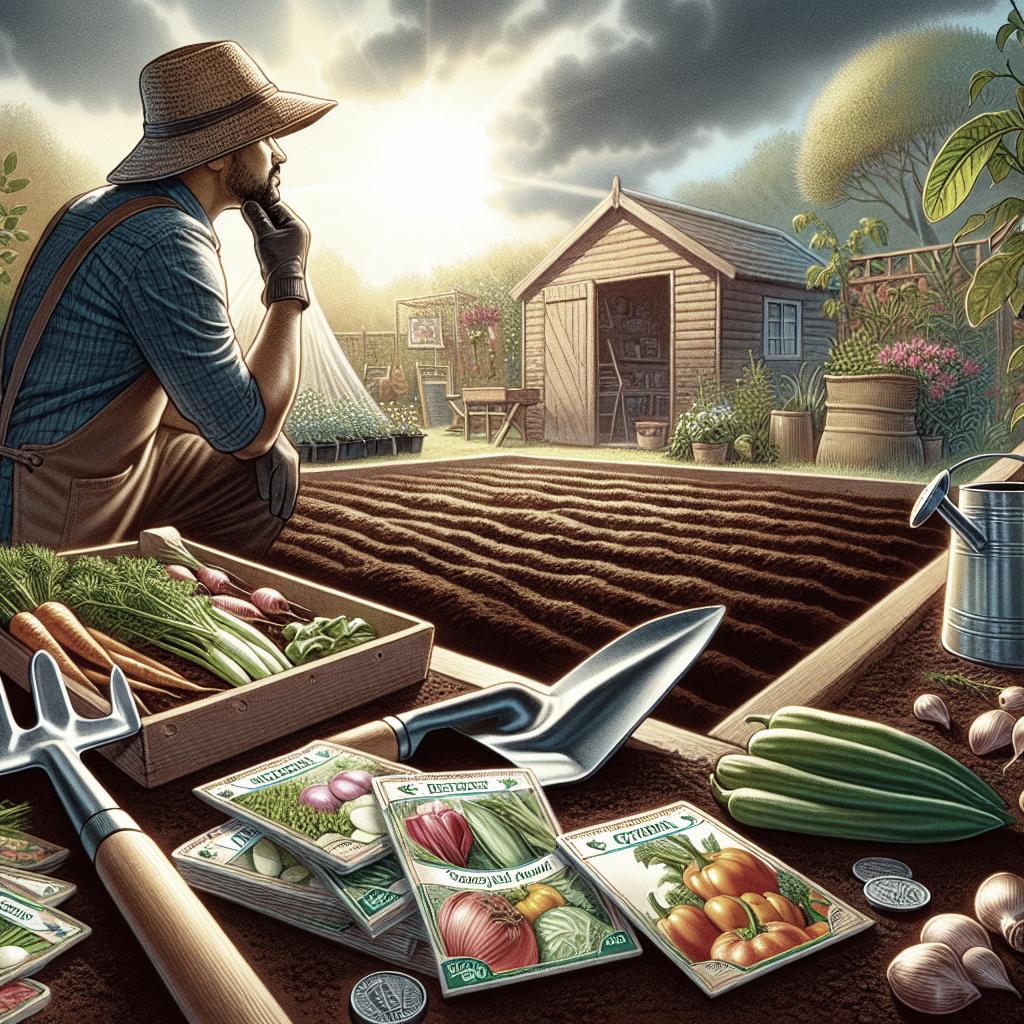“`html
Seasonal Gardening Tips for Beginners
Gardening offers a rewarding journey for beginners and experienced enthusiasts alike. With spring unfolding, it’s the perfect time to rejuvenate and prepare your garden for the upcoming lively growth and blossoms. This blog post provides novice gardeners with a multitude of tips and tricks to navigate the seasonal tasks. From assessing the different levels of your yard, preparing crucial tools, tending to your lush greens, to understanding the importance of consistent care such as pruning, fertilizing, and mulching, you’ll find a comprehensive guide here. We’ll also delve into supporting local wildlife by maintaining clean bird baths and feeders and give insights on composting. Whether you’re planting your first seed or looking to fill in the empty spots in your garden, these insights aim to inspire a lush, vibrant environment right in your backyard.
Spring Gardening for Beginners: Tips and Tricks
Spring is a season of renewal, and the garden is no exception. As daylight extends and the earth warms, it’s time for beginners to hit the ground running. Spring presents an excellent opportunity to take stock of your garden, preparing for a year of growth. The first step for any gardener should be to understand the scope and needs of their garden space.
This means observing the garden’s exposure to sunlight, understanding its soil type, and identifying what plants are likely to thrive. Following this fundamental assessment, both garden maintenance tasks like pruning and proactive measures such as planting new flora are essential to a thriving garden.
Survey Every Level of Your Yard
Top Level
The top level encompasses everything from tree canopies to trellises. Springtime care might include trimming and training your trees or larger shrubs to promote healthy new growth. Pay special attention to dead branches which should be removed to prevent damage from spring winds or pests. Leveraging ladders or long-handled tools can help safely reach those higher areas.
This assessment also includes inspecting vertical structures like walls or fences where climbing plants may grow. A sound support structure is vital for vines and creepers to flourish. Early spring is a great time to reinforce these supports before the plants start to weigh them down.
Middle Level
The middle level concerns plants, shrubs, and bushes that hover closer to ground level. Mulching around these plants serves a dual purpose — it retains moisture in the soil and suppresses weeds which might compete for nutrients. Establishing a strong mulching routine ensures that your mid-level plants receive the hydration and space they need.
Additionally, look at the layout: are plants spaced to allow sun exposure and airflow? Spring is the perfect time to re-space plants to avoid future crowding, especially if any outgrew their location from seasons past.
Lower Level
Close to the earth, the lower level is the home to groundcovers and the garden bed itself. Assessing and amending garden beds should be a top priority. Testing soil quality and content can guide appropriate amendments — perhaps your soil needs more organic matter or nutrients.
A healthy soil foundation supports everything above it. Replace or refresh edging as needed to define planting beds clearly. In this layer, attention to compost will also benefit the overall growth potentials of your garden plants.
Prepare Your Garden Tools
Your garden tools are an extension of your hands, and thus their condition directly impacts your efficiency and outcome in the garden. Before starting any spring tasks, take inventory of your tools. Properly clean off any dirt or rust that may have accumulated over the winter months with a basic brush, water, and rust remover where necessary.
Treat wooden handles with linseed oil to prevent drying and splitting, while sharpened edges on shears, pruners, and hoes make cutting through stems and soil much easier. Investing the time to maintain your tools will also prolong their lifespan, saving costs in the long run.
Fill in Gaps
Throughout any garden, there will invariably be gaps — spots where a plant has died, was removed, or simply never filled in. Spring is an excellent time to survey your garden and take stock of these spaces. Filling these gaps with annuals or perennials can enhance the overall aesthetic while promoting a diverse ecosystem.
When choosing plants, consider both their visual appeal and the role they’ll play in your garden. You might, for example, add a fragrant herb or a pollinator-friendly flower to attract beneficial insects.
Tend to Your Lawn
Prepare Your Lawn Mower
Your lawn mower is a pivotal tool for keeping your turf tidy and lush. Before you take it for its first spin of the season, it’s crucial to ensure it’s running efficiently. Clean the mower deck to prevent any build-up of clippings that could cause rust or combustion issues. Sharpen the mowing blades to ensure each cut is clean and safe for the grass, promoting healthier regrowth.
Additionally, check oil levels, inspect air filters, and make sure the spark plugs are in working order. A well-maintained mower turns an often dreaded chore into an efficient and even enjoyable task.
Make a Watering Schedule
With warmer temperatures, consistent watering becomes paramount. The extremes of over or under-watering can damage your lawn and negate any efforts you’ve put in. Creating a regular schedule that considers your local climate, typical rainfall, and grass type can support strong, healthy growth.
Mornings are the ideal time to water your lawn, minimizing evaporation and mold risks. As spring progresses, adjust frequency as necessary to ensure your grass gets deep watering without becoming soggy.
Prune Shrubs
Pruning is a vital horticultural practice that encourages healthy shrubs and flowering plants. It’s best done in early spring, before many plants have set their buds for the next cycle of flowering. When pruning, always cut at an angle just above a bud to promote outward facing growth.
The goal of pruning is not only to maintain a structured form but to remove any damaged, diseased, or dead branches that could harm the plant over time. Whenever you prune, step back and ensure that you’re maintaining the natural shape of the plant for a tidy but natural look.
Prepare New Beds
Creating a new flower or vegetable bed adds diversity to your garden. Start by deciding on the location, considering the sunlight and drainage needs of the plants you wish to grow. Preparing the area begins with removing sod or weeds and then tilling the soil for aeration.
Mix in organic matter such as compost to enrich the soil, ensuring a fertile base for your plants. Understanding the specific pH and nutrient needs of your intended new plantings can help tailor the bed perfectly before planting season is fully underway.
Plant from Bare-Root
Bare-root plants offer a cost-effective solution and often take less space during transport and planting compared to their container-grown counterparts. You can plant them while they are dormant in early spring, giving them an excellent start before the growing season kicks into high gear.
When handling bare-root plants, ensure that their roots never dry out. Soak them briefly before planting and keep the roots spreading out in the hole, covered thoroughly but gently with soil. Watering immediately after planting encourages a successful establishment.
Plant Container Plants
Container plants are a popular option for gardeners aiming for instant visual appeal, as they are already mature and ready to take off. When planting them, ensure the containers are well-drained to prevent waterlog.
When transferring from containers, take care not to disturb the root structure too much, though teasing out the roots slightly can encourage spreading. Place them into prepared beds, ensuring they are at the depth they were growing in their pots for best results.
Fertilize
Fertilizing provides plants with essential nutrients, catalyzing their growth and flowering ability. Spring naturally aligns with many plants’ developmental stages perfect for fertilizing. Evaluate what kind of fertilizer is suitable based on your plant types — balanced, nitrogen-rich, or specific to flowers or fruits.
Be mindful of measurements; applying too much could lead to nutrient burn, harming your plants more than helping. Regular applications, with timers or conscious calendar reminders, keep your garden nourished and thriving.
Start a Compost Pile
Hot Pile
Hot composting is a faster process that involves maintaining the internal heat of the compost pile at a higher temperature, roughly between 130°F and 150°F. Achieving this necessitates a balance of green and brown organic materials, moisture, and regular turning.
This technique rapidly decomposes matter into rich, organic fertilizer for your garden. It’s efficient when you need compost quickly, yet requires more active management.
Cold Pile
Cold composting takes a more laid-back approach, allowing organic material to decompose over a longer period. Pile up grass clippings, leaves, and kitchen scraps, and let nature take its course. Regular turning is optional but can accelerate the process moderately.
This method may take a year or more for full decomposition, and while slower, it requires less effort and intervention than hot composting.
Clean Bird Feeders and Baths
How to Clean Bird Feeders
Regular maintenance of bird feeders is critical to ensure that backyard visitors remain healthy and disease-free. Take down feeders periodically and scrub them thoroughly with a mixture of bleach and water (9:1 ratio), then rinse and dry completely before refilling.
Pick a sunny day for cleaning to speed the drying process, minimizing mold growth. Establishing a cleaning routine ensures a consistent offering of safe, nutritious food for the local bird population.
How to Clean a Bird Bath
Bird baths also require upkeep to stay hygienic for feathered guests. Use a similar bleach solution and a scrub brush to eliminate any algae, grime, or residue. Drain the old water, clean thoroughly, rinse several times, and refill with fresh water.
Placing your bird bath in partial shade can reduce algae growth, and consistently maintaining it prevents stagnation, inviting more birds to bathe.
Add Mulch
Mulching is one of the most beneficial calls to action for a thriving garden. It prevents weeds, retains moisture, and eventually decomposes to enrich the soil. Choose organic mulch for added benefits, such as bark, wood chips, or shredded leaves.
Apply mulch in a 2 to 4-inch layer around the bases of your plants. Be careful not to pile mulch directly against plant stems or tree trunks, as this can cause rot issues. Regularly replenishing mulch sets a firm foundation for a wide spectrum of flourishing plants.
Final Thoughts
| Task | Description |
|---|---|
| Survey Yard Levels | Assess your garden at top, middle, and lower levels to tailor care needs. |
| Prepare Tools | Clean and maintain your gardening tools for optimal performance. |
| Fill Gaps | Identify and plant in garden voids to ensure an even and lush landscape. |
| Tend to Lawn | Maintain a mowing and watering schedule to foster a healthy lawn. |
| Prune Shrubs | Cut back shrubs to encourage healthy new growth and structure. |
| Prepare Beds | Develop new garden beds with enriched soil for additional plantings. |
| Planting | Set bare-root and container plants with consideration to growth requirements. |
| Fertilize | Feed plants with suitable nutrients to promote growth and blooms. |
| Start Compost | Create either hot or cold compost piles for rich organic material. |
| Clean Bird Feeders and Baths | Maintain cleanliness to support healthy bird visitors in your garden. |
| Add Mulch | Apply a protective and enriching layer of mulch around plants. |
“`

